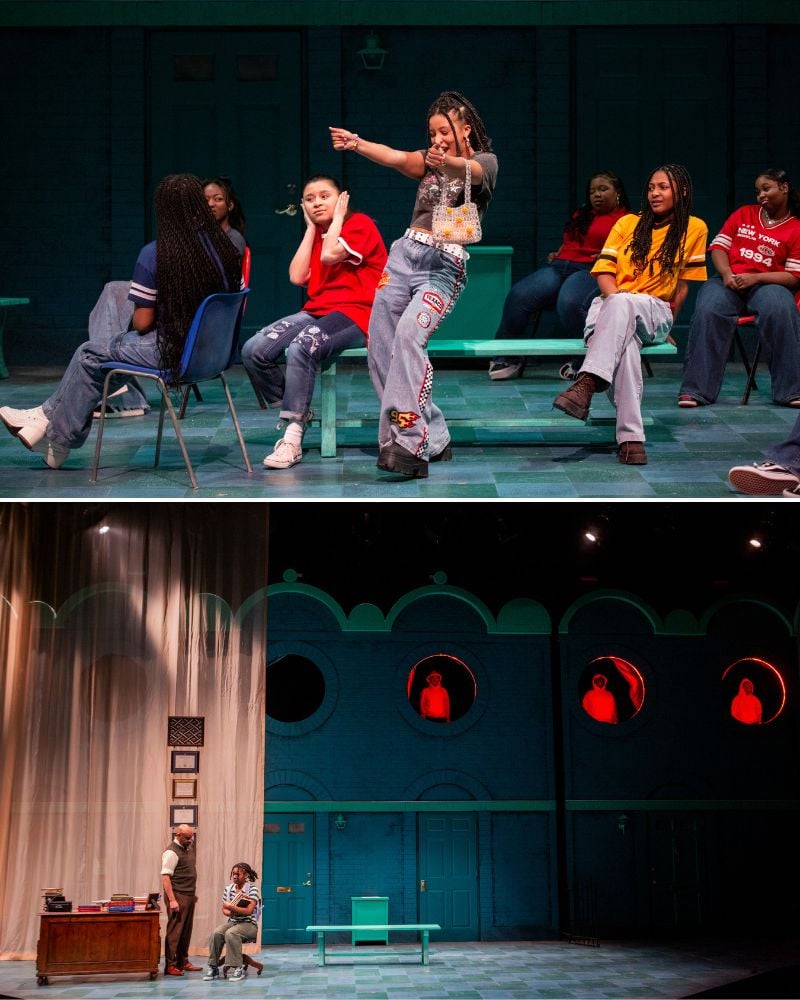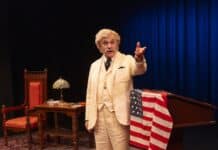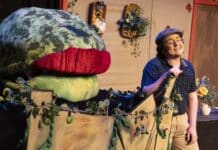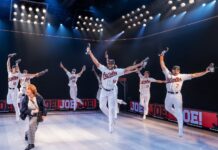In Baltimore Center Stage’s current family-oriented show, Akeelah and the Bee, an urban young person suffering from a lack of positive attention gets pulled into competitive spelling and discovers several unimagined worlds alongside her own. Based on the 2006 film featuring young Keke Palmer, this production has every reason to delight theatergoers: broad appeal, representation, drama, humor, lively action, and local references.
Akeelah and the Bee, playing now through April 13, is a nationally relatable story, or should be, though I understand there are great swaths of America that have no Black people in them at all. For Baltimore, it’s a darn close approximation of us and includes some hometown touches. If you’re not familiar with the 2006 movie by the same title, you’ll get to see something brand new. If you are familiar with Doug Atchison’s movie, you also get to see something new. The movie is moody and gritty. The stage production is sassy, friendly, and jubilant.

Playwright Cheryl L. West makes several important, enriching adaptations from the screenplay, condensing Akeelah’s family and adding neighborhood characters, focusing on relationships, interdependence, and community. Like the movie, the play centers on non-white characters who may not look like all parts of the U.S., but certainly very like Baltimore. Baltimore Center Stage puts a Baltimore twist on it, not shying away from the violence of some of the neighborhoods in which our children are expected to live, thrive, overcome, stay out of trouble, and perform well academically. Akeelah and the Bee is part of ongoing Baltimore Center Stage’s youth programs.
Baltimore Center Stage’s production of Akeelah and the Bee includes students from Baltimore School of Arts (BSA), freshmen and sophomore actors. Having high school students portray middle school students theoretically should work, especially for freshmen, who have recently left middle school. These kids, however, are physically larger than middle school students and, as written, imbued with loftier ambitions and inflated street savviness, so it’s a hybrid of middle and high school aesthetics and concerns. BSA freshman Natalya Benton does a splendid rendition of Akeelah, and her interactions with her onstage mother and brother (Zipporah Brown Gladden as Gail Anderson and Theodore Sherron III as Reggie Anderson, respectively) are authentic and relatable.
The performances that the actors, including the BSA students, deliver are nuanced, authentic, and familiar, sometimes uncomfortably so. The neighborhood surrounding Akeelah is populated with archetypical locals, including Miz Ruth, played by Morgan Stage graduate Tracy “Symphony” Hall with warmth, humor, and Baltimore drip. Among students, standout performances include Tonica “Toni” Davis as antagonistic Ratchet Rhonda, Grace Elizabeth Rolley as fabulously visual spelling contender Mohawk Girl, William “Will” Dombrowski as Akeelah’s new friend and champion Javier Mendez, Chloé Sheppard as design-hopeful bestie Georgia, and Braxton Singhanath as a surprisingly sympathetic arch-competitor Dylan Chiu.
The adult cast, many of whom have local connections, are also delightfully watchable. ArtsCentric and ChesShakes veteran Quincy Vicks as neighborhood “lord” JT has few lines but lots of expressiveness, Dwayne Alistair Thomas, who portrays Drunk Willie, is a hoot with physical comedy, and Jefferson A. Russell, an Everyman company member, playing stuffy Dr. Joshua Larabee nails his underlying torment. This deeply educational opportunity for the BSA students to work alongside professional actors, to see up close many different ways in which to be a working artist, is heartwarming and encouraging beyond artistry, at a very basic human level.

Scenic Designer Anton Volovsek presents a single set that does everything required without fuss or ostentation. The set is very, very green. It’s nearly remarkable how green it is. In that way, it resembles no neighborhood or building in Baltimore, announcing silently that it is meant as representation, not reproduction. The back wall is a green brick facade inset with round windows and brick arches above. At street level, doors with an assortment of brass fittings provide entrances and exits, as well as separation between dwellings. It serves as both exterior and interior, with seamlessly choreographed transitions between sequences. The floor, patterned in four or five different green/blue tile textures, hides surprises, and the apparent simplicity of the set is quite literally a facade for some very elegant underlying complexities. Contrasting geometry captures the eye of the audience before the set is even lit, and the onstage action spills over into the first couple of rows in the audience. We are not watching a show about Akeelah and her spelling bee; we are part of her community.
Director Jerrica D. White keeps the action snappy. Her choices about character interactions and added Baltimore touches bring the people of Baltimore into the story. Using actors who are already onstage as Run Crew for set changes accelerates the pace of the play, and there is no lag at all between one scene and the next. Transitions happen during dialogue, so the whole show moves quickly.
Seats at Center Stage are comfortable, the aisles are reasonable, and the sightlines are excellent. This is a great show for families, appropriate for anyone over the age of 10, and even younger if you’re okay with minor swear words. It depicts real-life working family, found and biological, with flaws and challenges, facing issues more weighty than Brady Bunch sitcom plots. Single parenthood, teen parenthood, gun violence, substance abuse, bullying, socioeconomic inequity, and neglect of the “good” child in favor of the “troubled” one are more pressing than popularity or prom in this show, giving it an all-ages vibe rather than a middle- or high-school one.
If you’re interested in supporting young working actors, other than being a parent to one, the thing to do is show up and appreciate their craft. A warm audience is the best friend an actor can have no matter what age, but it’s especially important to the young ones, and the applause of strangers holds a different level of meaning than the cheers of loved ones. The cast of Akeelah and the Bee gets, and deserves, both. Join in, won’t you?
Running Time: Two hours and 20 minutes, with one 15-minute intermission.
Akeelah and the Bee plays through April 13, 2025 (Wednesdays through Saturdays at 7:30 PM; 2:00 PM on Saturdays; 3:00 PM on Sundays), at Baltimore Center Stage, 700 North Calvert Street, Baltimore, MD. For tickets ($10–$90, with senior and student discounts available), call the box office at (410) 332-0033 (Tuesday through Friday, noon–5 pm), email boxoffice@centerstage.org, or purchase them online.
The program for Akeelah and the Bee is available online here.
COVID Safety: Masks are encouraged and welcomed but not required.
Final Factoid: Screenwriter Doug Atchison, who is not African American, conceived the premise for Akeelah and the Bee after seeing the 1994 Scripps National Spelling Bee and noting that most competitors came from secure socioeconomic backgrounds. After completing the script, Atchison was unable to secure backing from a production company until 2004. In the following year, it was filmed in South L.A. and released in 2006.
Akeelah and the Bee
By Cheryl L. West
Directed by Jerrica D. White
Based on the original screenplay by Doug Atchison




